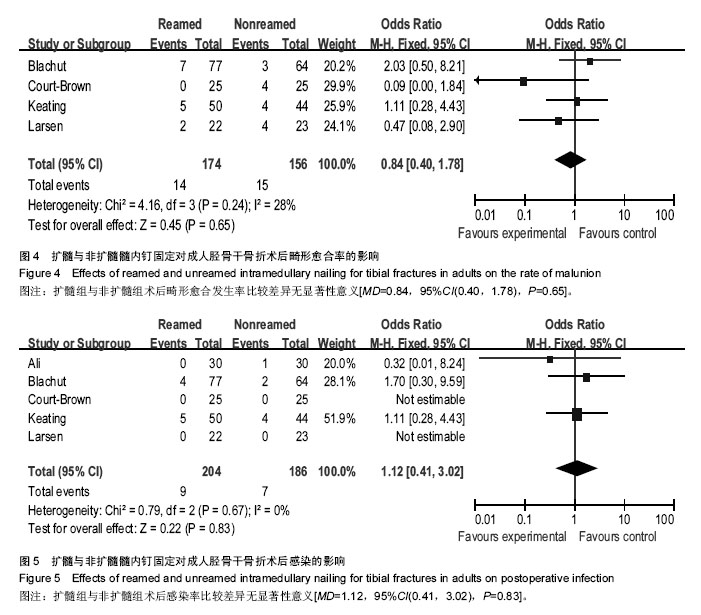| [1] 胥少汀,葛宝丰,徐印坎.实用骨科学[M].3版.北京:人民军医出版社,2008:779.
[2] Gugala Z,Nana A,Lindsey RW. Tibial intramedullary nail distal interlocking screw placement:comparison of the free-hand versus distally-based targeting device techniques.Injury.2001;32 Suppl 4:S21-25.
[3] Court-Brown CM,Christie J,McQueen MM.Closed intramedullary tibial nailing. Its use in closed and type I open fractures.J Bone Joint Surg Br.1990;72(4):605-611.
[4] Ekeland A,Thoresen BO,Alho A,et al.Interlocking intramedullary nailing in the treatment of tibial fractures.A report of 45 cases.Clin Orthop Relat Res. 1988;(231):205-215.
[5] Jadad AR,Moore RA,Carroll D,et al.Assessing the quality of reports of randomized clinical trials:is blinding necessary.Control Clin Trials.1996;17(1):112.
[6] Court-Brown CM,Will E,Christie J,et al.Reamed or undreamed nailing for closed tibial fractures: a prospective study in Tscherne C1 fractures.J Bone Joint Surg.1996; 78(4): 580-583.
[7] Blachut PA,O’Brien PJ,Meek RN,et al.Interlocking intramedullary nailing with and without reaming for the treatment of closed fractures of the tibial shaft: a prospective ,randomized study.J Bone Joint Surg. 1997;79(5):640-646.
[8] Keating JF, O’Brien PJ, Blachut PA. Locking intramedullary nailing with and without reaming for open fractures of the tibial shaft: a prospective, randomized study. J Bone Joint Surg, 1997;79(3): 334-341.
[9] Nassif JM,Gorczyca JT,Cole JK,et al.Effect of acute reamed versus unreamed intramedullary nailing on compartment pressure when treating closed tibial shaft fractures: a randomized prospective study.J Orthop Trauma.2000;14:554-558.
[10] Larsen LB,Madsen JE,Hoiness PR,et al.Should insertion of intramedullary nails for tibial fractures be with or without reaming? A prospective, randomized study with 3.8 years’ follow-up.J Orthop Trauma.2004; 18:144-149.
[11] Bhandari M,Guyatt G,Tornetta P,et al.Randomized trial of reamed and unreamed intramedullary nailing of tibial shaft fractures.J Bone Joint Surg Am.2008;90: 2567-2578.
[12] Sadighi A,Elmi A,Jafari MA,et al.Comparison study of therapeutic results of closed tibial shaft fracture with intramedullary nails inserted with and without reaming. Pak J Biol Sci.2011;14:950-953.
[13] Klein MP,Rahn BA,Frigg R,et al.Reaming versus non-reaming in medullary nailing: interference with cortical circulation of the canine tibia.Arch Orthop Trauma Surg. 1990;109:314-316.
[14] Schemitsch EH,Kowalski MJ,Swiontkowski MF,et al.Effects of reamed versus undreamed locked nailing on callus blood flow and early strength of union in a fractured sheep tibia model.Orthop Trans.1994;18:145.
[15] Brinker MR,Cook SD,Dunlap JN,et al.Early change in nutrient artery blood flow following tibial nailing with and without reaming : a preliminary study. J Orthop Trauma. 1999;13:129-133.
[16] Schemitsch EH,Turchin DC,Kowalski MJ,et al. Quantitative assessment of bone injury and repair after reamed and unreamed locked intramedullary nailing.J Trauma.1998; 45:250-255.
[17] Lindstrom T,Gullichsen E,Lertola K,et al.Leg tissue perfusion in simple tibial shaft fracture treated with unreamed and reamed nailing.J Trauma.1997;43: 636-639.
[18] Arazi M,Ogun TC,Oktar MN,et al.Early weight-bearing after statically locked reamed intramedullary nailing of comminuted femoral fractures: is it a safe procedure.J Trauma.2001;50(4):711-716.
[19] Reichert IL,McCarthy ID,Hughes SP.The acute vascular response to intramedullary reaming: microsphere estimation of blood flow in the intact ovine tibia.J Bone Joint Surg Br.1995;77(3):490-493.
[20] Fotster MC,Bruce AS,Aster AS.Should the tibia be reamed when nailing.Injury. 2005;36(3):439-444. |
.jpg)



.jpg)